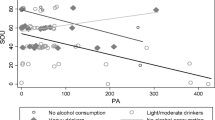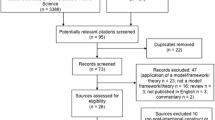Abstract
Rationale
The effects of acute bouts of physical activity (PA) on Strength of Desire (SoD) and Desire to Smoke (DtS) using individual participant data (IPD) from 19 acute randomised controlled studies were quantified. However, there is a need to identify factors influencing this relationship.
Objectives
To understand who most benefits from PA, whether changes in affect mediate these effects and whether any specific attributes of PA are associated with cigarette cravings.
Methods
IPD (n = 930) contributed to one-stage IPD meta-analyses. Participants engaging in PA were compared against controls, using post-intervention DtS and SoD (when DtS is not available) with baseline adjustments. The craving scales were linearly rescaled to 0–100 % (a mean difference between groups of −10 would indicate that post-intervention cravings were 10 % lower in the PA compared with the control group). Demographic, smoking and other characteristics were examined as predictors and potential moderators, whereas change in affect was considered as a mediator. PA was categorised according to type, duration and intensity, to determine PA attributes associated with cravings reduction.
Results
None of the included covariates were shown to moderate or mediate the effects of PA. Intensity of PA was significantly associated with a reduction in cravings; moderate and vigorous intensity PA offered the most benefits. A one-stage IPD meta-analysis yielded effect sizes of −9.22 (−15.24; −3.20) for light, −34.57 (−42.64; −26.50) for moderate and −31.29 (−38.00; −24.57) for vigorous intensity in comparison with controls.
Conclusions
Moderate intensity PA could be recommended to all smokers regardless of demographic, smoking and other characteristics.
Similar content being viewed by others
References
Blair SN, Haskell WL, Ho P, Paffenbarger RS Jr, Vranizan KM, Farquhar JW, Wood PD (1985) Assessment of habitual physical activity by a seven-day recall in a community survey and controlled experiments. Am J Epidemiol 122:794–804
Borg G (1998) Borg’s perceived exertion and pain scales. Human Kinetics, Champaign
Craig CL, Marshall AL, Sjöström M, Bauman AE, Booth ML, Ainsworth BE, Pratt M, Ekelund U, Yngve A, Sallis JF, Oja P (2003) International physical activity questionnaire: 12-country reliability and validity. Med Sci Sports Exerc 35:1381--95
Eastwood P (2012) Statistics on smoking: England, 2012. Health and Social Care Information Centre. https://catalogue.ic.nhs.uk/publications/public-health/smoking/smok-eng-2012/smok-eng-2012-rep.pdf. Accessed 21 Apr 2013
Ekkekakis P, Parfitt G, Petruzzello SJ (2011) The pleasure and displeasure people feel when they exercise at different intensities: decennial update and progress towards a tripartite rationale for exercise intensity prescription. Sports Med 41:641–671
Everson ES, Taylor AH, Ussher M (2010) Determinants of physical activity promotion by smoking cessation advisors as an aid for quitting: support for the transtheoretical model. Patient Educ Couns 78:53–56
Fagerström K (1978) Measuring degree of physical dependence to tobacco smoking with reference to individualization of treatment. Addict Behav 3:235–241
Fagerström K (2012) Determinants of tobacco use and renaming the FTND to the Fagerström Test for Cigarette Dependence. Nicotine Tob Res 14:75–78
Haasova M, Warren FC, Ussher M, Van Rensburg KJ, Faulkner G, Cropley M, Byron-Daniel J, Everson-Hock ES, Oh H, Taylor AH (2013) The acute effects of physical activity on cigarette cravings: systematic review and meta-analysis with individual participant data. Addiction 108:26–37
Hardy CJ, Rejeski WJ (1989) Not what, but how one feels—the measurement of affect during exercise. J Sport Exerc Psychol 11:304–317
Higgins JP, Whitehead A, Turner RM, Omar RZ, Thompson SG (2001) Meta-analysis of continuous outcome data from individual patients. Stat Med 20:2219–2241
Kraemer HC, Wilson GT, Fairburn CG, Agras WS (2002) Mediators and moderators of treatment effects in randomized clinical trials. Arch Gen Psychiatry 59:877–883
Lambert PC, Sutton AJ, Abrams KR, Jones DR (2002) A comparison of summary patient-level covariates in meta-regression with individual patient data meta-analysis. J Clin Epidemiol 55:86–94
Lyratzopoulos G, Elliott M, Barbiere JM, Henderson A, Staetsky L, Paddison C, Campbell J, Roland M (2012) Understanding ethnic and other socio-demographic differences in patient experience of primary care: evidence from the English General Practice Patient Survey. BMJ Qual Saf 21:21–29
Moher D, Liberati A, Tetzlaff J, Altman DG, Group P (2009) Preferred reporting items for systematic reviews and meta-analyses: the PRISMA statement. Br Med J 339:b2535
Parrott AC (1998) Nesbitt’s Paradox resolved? Stress and arousal modulation during cigarette smoking. Addiction 93:27–39
Reed J, Ones DS (2006) The effect of acute aerobic exercise on positive activated affect: a meta-analysis. Psychol Sport Exerc 7:477–514
Riley RD, Lambert PC, Abo-Zaid G (2010) Meta-analysis of individual participant data: rationale, conduct, and reporting. BMJ 340:c221
Riley RD, Higgins JP, Deeks JJ (2011) Interpretation of random effects meta-analyses. BMJ 342:d549
Roberts V, Maddison R, Simpson C, Bullen C, Prapavessis H (2012) The acute effects of exercise on cigarette cravings, withdrawal symptoms, affect, and smoking behaviour: systematic review update and meta-analysis. Psychopharmacology 222:1–15
Russell J (1980) A circumplex model of affect. J Pers Soc Psychol 39:18
Steptoe A, Ussher M (2006) Smoking, cortisol and nicotine. Int J Psychophysiol 59:228–235
Stewart LA, Tierney JF, Clarke M (2011) Chapter 18: Reviews of individual patient data. In: Higgins JPT, Green S (ed) Cochrane Handbook for Systematic Reviews of Interventions. http://handbook.cochrane.org/. Accessed 4 Feb 2014
Svebak S, Murgatroyd S (1985) Metamotivational dominance: a multimethod validation of reversal theory constructs. J Pers Soc Psychol 48:107–116
Taylor AH, Ussher MH, Faulkner G (2007) The acute effects of exercise on cigarette cravings, withdrawal symptoms, affect and smoking behaviour: a systematic review. Addiction 102:534–543
Tiffany ST, Drobes DJ (1991) The development and initial validation of a questionnaire on smoking urges. Br J Addict 86:1467–1476
Ussher MH, Taylor AH, Faulkner G (2012) Exercise interventions for smoking cessation Cochrane Database Syst Rev Issue 1. Art. No.: CD002295. doi:10.1002/14651858.CD002295
West R, Hajek P (2004) Evaluation of the mood and physical symptoms scale (MPSS) to assess cigarette withdrawal. Psychopharmacology 177:195–199
West RJ, Russell MAH (1985) Pre-abstinence smoke intake and smoking motivation as predictors of severity of cigarette withdrawal symptoms. Psychopharmacology 87:334–336
Acknowledgments
We would like to thank all the authors of individual studies for their co-operation, without which this study would not have been possible. And we would like to thank our reviewers and the editor for their helpful comments, which enabled us improve the paper.
Conflict of interest
This research was conducted with the support of internal institutional funds. The authors have received no other direct or indirect support, and none of the researchers have any connection with the tobacco or pharmaceutical industries. Some authors (M.H.; M.U.; K.J.V.R; G.F.; M.C.; J.B.D.; E.E.H.; H.O.; A.H.T) are also authors of some of the included primary studies.
Author information
Authors and Affiliations
Corresponding author
Electronic supplementary material
Below is the link to the electronic supplementary material.
ESM 1
(DOCX 37.2 kb)
Rights and permissions
About this article
Cite this article
Haasova, M., Warren, F.C., Ussher, M. et al. The acute effects of physical activity on cigarette cravings: Exploration of potential moderators, mediators and physical activity attributes using individual participant data (IPD) meta-analyses. Psychopharmacology 231, 1267–1275 (2014). https://doi.org/10.1007/s00213-014-3450-4
Received:
Accepted:
Published:
Issue Date:
DOI: https://doi.org/10.1007/s00213-014-3450-4




